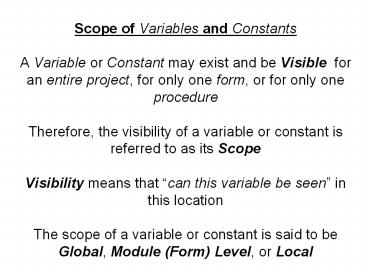Scope of Variables and Constants A Variable or Constant may exist and be Visible for an entire project, for only one form, or for only one procedure Therefore, the visibility of a variable or constant is referred to as its Scope Visibility means that PowerPoint PPT Presentation
1 / 17
Title: Scope of Variables and Constants A Variable or Constant may exist and be Visible for an entire project, for only one form, or for only one procedure Therefore, the visibility of a variable or constant is referred to as its Scope Visibility means that
1
Scope of Variables and ConstantsA Variable or
Constant may exist and be Visible for an entire
project, for only one form, or for only one
procedureTherefore, the visibility of a
variable or constant is referred to as its
ScopeVisibility means that can this variable
be seen in this locationThe scope of a
variable or constant is said to be Global, Module
(Form) Level, or Local
2
Module Level variables or constants are
accessible from all procedures of a FormA Local
variable or constant may be used only within the
procedure in which it is declaredThe Scope of
a Variable declared with a DIM statement is
determined by where the declaration statement is
madeThe Lifetime of a Variable is the period of
time that the variable existsThe Lifetime of a
Local variable is normally one execution of the
procedureThe Lifetime of a Module Level variable
is the entire time the Form is Loaded (generally
the lifetime of the entire project)
3
(No Transcript)
4
Local Declarations
- Any variable you declare inside a procedure
- The lifetime of the variable is one execution of
the procedure - Each time you execute (e.g. click on a command
button) a procedure, the local DIM statements are
executed. - Each variable is created as a fresh new one
with an initial value of 0 for numeric datatypes
or for string - When the procedure finishes, its variables
disappear, their memory locations are released
5
Local Declarations
6
Module-Level Declarations
- When you need to use a variable or constant in
more than one procedure of a form - Declare at module-level
- General Declarations
7
Module-Level Declarations
8
Global Variables
- Though you can declare global variables anywhere,
convention dictates that public variables be
placed only in the standard code module. - Examples of global and module level declarations
in a SCM - Public gcurTotalSalary as Currency 'global
variable - Public Const gcurTAX_RATE as Single .082
'global constant - Dim mcurMySalary as Currecy 'module-only variable
- If a procedure were to contain a variable
declared locally whose name is the same as a
global variable (a violation of unwritten
convention for variable naming), then the local
variable takes precedence. A local variable, when
in scope, always preempts use of a global
variable. - The Private statement is rarely used, because
that is the default (for Dim)
9
Static Variables
- Static variables are local to a procedure but
retain their value for the life of a project.
They are often used inside a procedure that
counts things and must maintain that count.
Static variables are initialized once only.
Thereafter they are not initialized during the
project - Private Sub Something()
- Static intCount as Integer 'initialized
to 0 once - intCount intCount 1 'remembered across
invocations - End Sub
10
Standard Code Modules
- Public procedures arevisible to all forms
- Public variables are visible to all forms
- SCM has the extension .BAS
- Create SCM Project, Add Module
- DIM variables in the code module are visible to
all procedures in the module, but not to
procedures in the form modules. - SCM modules do not have any event procedures
because SCM has no events to which it can react.
The SCM only has code and procedures.
11
Identifiers
- When you use variables and constants, it is
important that you know their scope. Good
programming practice to include scope information
in naming conventions - Use m as a prefix to identify module-level
declarations - Use g to identify variables with global scope
12
Multi-Form ProjectsWorking with more than one
form in a projectThe first form that VB
displays is called the STARTUP FORMTo add
another form Project Menu/Add Form or select the
icon from the shortcut toolbarThis form will be
added to the project, and cam be viewed from the
Project Explorer Window
13
Each form is a separate entity, and the code
exists and is related only to the specific
formTo move between each formFORMNAME.SHOWFO
RMNAME.HIDEForm style can be 1 (modal) or the
default value 0 (nonmodal)
14
Variables Constants in Multi-form Projects
- Scope of variables
- Local available inside a procedure
- Static inside procedure, but remembered
- Module level available anywhere in a form
- Global available across forms--anywhere
- Global variables declared with Public
- Variable prefix naming conventions m for module,
g for global - Scope a variable as narrowly as possible
15
Referring to Other Forms Objects
- You can refer to txtName in another form called
frmSummary this way - frmSummary!txtName
- or frmSummary!txtName.Font.Name ...
- This implies that control names are unique within
a form but need not be unique across forms.
16
An About Box
- Acts like a Windows HelpAbout box
- Often displays information about the programmers,
designers, and so on - An about box is simply a modal form with an OK
button and label boxes displaying information - You can use VBs About Dialog template
17
A Splash Screen
- Splash screen displays while product loads
- Create Project, Add Form, then select Splash
Screen - Splash screen loads first instead of main form
- Place splash screen load statement in Sub Main
procedure in Standard Code Module

